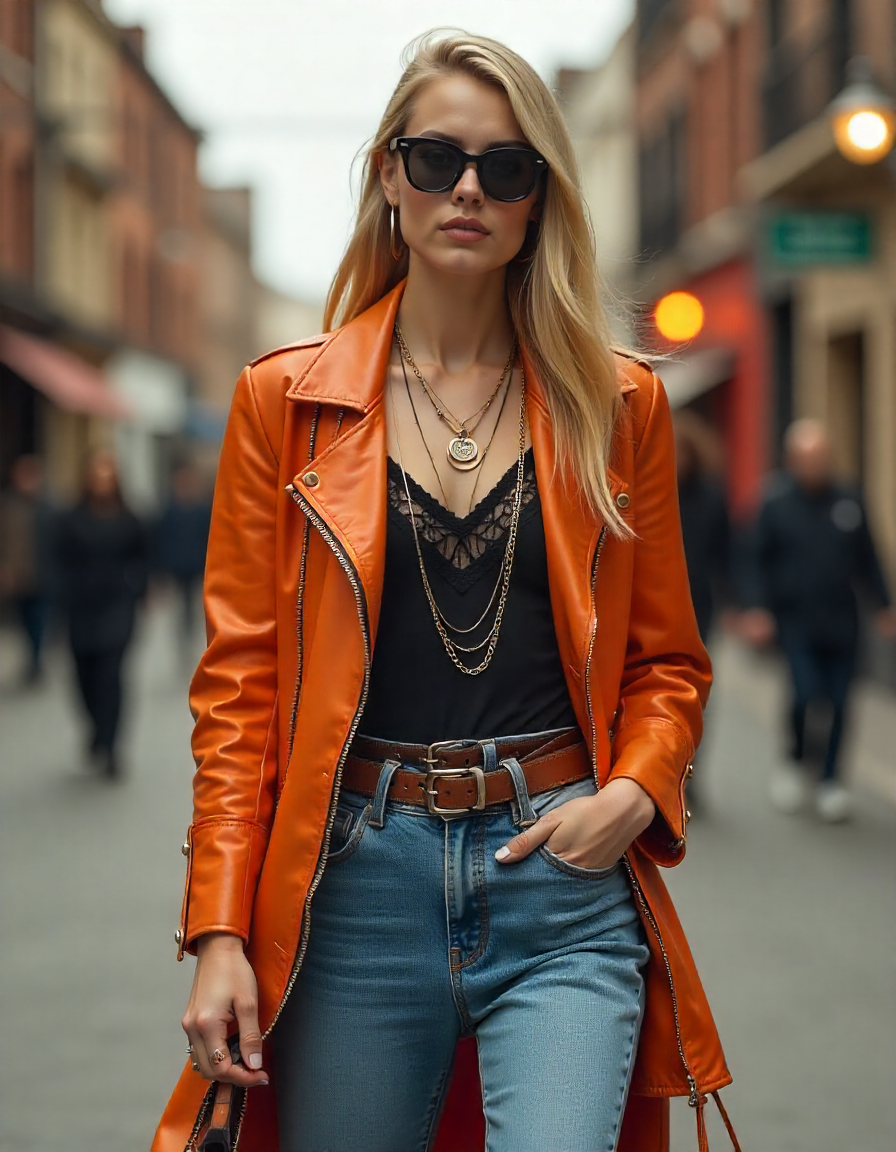Streetwear has come a long way since its roots in the skate parks and hip-hop scenes of the 1980s. Back then, it was all about functionality—baggy jeans for movement, hoodies for warmth, and sneakers built to last through endless tricks or cyphers. Brands like Stüssy and Supreme started as small operations, printing graphics on tees that captured the rebellious spirit of youth. Fast forward to today, and streetwear dominates luxury catwalks. Think about Virgil Abloh’s tenure at Louis Vuitton, where he blended graffiti motifs with tailored suits, turning everyday gear into collector’s items.
What’s driving this shift? Social media plays a huge role. Platforms like Instagram let influencers showcase outfits that mix high-end pieces with thrift finds, democratizing style. Drops from brands like Off-White create hype, with limited releases selling out in minutes. But there’s depth here beyond the buzz. Streetwear promotes inclusivity, breaking down barriers between genders and classes. Women rock oversized bombers just as men do, and affordable collabs with giants like Nike make premium looks accessible.
For those looking to dip in, start with staples: a crisp pair of Air Force 1s, a graphic hoodie, and straight-leg pants. Layer with accessories like chain necklaces or bucket hats for personality. Sustainability is creeping in too—brands like Patagonia repurpose materials, proving you can look sharp without harming the planet. In 2025, expect more tech integrations, like smart fabrics that change color based on mood. Streetwear isn’t just clothing; it’s a statement of identity, evolving with each generation’s voice.
(Word count: 278)
Sustainable Threads: Why Bamboo and Hemp Are Revolutionizing Closets
Imagine slipping into a shirt that feels like silk but comes from a plant that grows faster than weeds. That’s the magic of bamboo fabric, a game-changer in eco-conscious dressing. Unlike cotton, which guzzles water and pesticides, bamboo thrives with minimal resources, regenerating quickly after harvest. It’s naturally antibacterial, wicking away moisture to keep you fresh during humid summers. Designers like Stella McCartney have championed it, weaving it into flowing dresses and breathable activewear.
Hemp steps up as another powerhouse. Often misunderstood due to its cannabis cousin, hemp fibers are incredibly durable, outlasting synthetics that end up in landfills. It requires little water and enriches soil as it grows, making it a farmer’s ally. Picture rugged jeans or soft linen-like tops that age gracefully, developing character over time. Brands such as Patagonia and Levi’s are incorporating hemp blends, reducing their carbon footprint while delivering timeless pieces.
Why care? The fashion industry churns out waste equivalent to a truckload every second. Switching to these materials cuts that down. For shoppers, it’s practical too—bamboo resists wrinkles, ideal for travel, and hemp’s strength means fewer replacements. Pair a hemp jacket with bamboo tees for an effortless outfit that’s kind to Earth. As regulations tighten on fast fashion, expect more innovations, like dyeing processes using natural pigments from berries or roots. Embracing these fabrics isn’t a trend; it’s a smart pivot toward a wardrobe that lasts and lightens our environmental load.
In my own experience, swapping to bamboo socks transformed long hikes—no more blisters or odors. It’s small changes like these that add up, proving sustainable choices enhance daily life without sacrificing style.
(Word count: 312)
Vintage Revival: Hunting Treasures in Thrift Shops and Online Markets
Thrifting isn’t just a budget hack; it’s a treasure hunt that uncovers pieces with stories etched into their seams. Remember that 1970s leather jacket your grandma wore to concerts? Items like that carry patina, a worn-in charm new clothes can’t replicate. In today’s market, vintage is booming, fueled by a desire for uniqueness amid mass-produced sameness. Platforms like Depop and Etsy make it easy to snag a 1950s swing dress or 1990s grunge flannel from sellers worldwide.
The appeal lies in quality. Older garments often use sturdy fabrics and craftsmanship forgotten in quick-turnaround factories. A wool coat from the 1940s might outlive several modern knockoffs. Plus, it’s eco-friendly—reusing extends a item’s life, slashing the need for new production. Celebrities like Zendaya rock red carpets in archived Chanel, inspiring fans to raid attics or local shops.
Tips for success: Know your sizes, as vintage cuts differ—try on or measure carefully. Look for labels like Yves Saint Laurent or Dior for investment value. Clean gently; a mix of vinegar and water revives musty smells without harsh chemicals. Online, check seller ratings and zoom in on photos for flaws. Mix vintage with contemporary: pair a retro blouse with slim jeans for balance.
This year, 2025, sees a surge in upcycled vintage—designers like Marine Serre transform old scarves into fresh tops. It’s empowering, letting you curate a look that’s truly yours. Last month, I scored a 1980s silk scarf at a flea market; tied around my bag, it sparks conversations everywhere. Vintage isn’t nostalgia; it’s forward-thinking fashion that honors the past while fitting the present.
(Word count: 289)
Accessory Alchemy: Transforming Outfits with Bold Jewelry and Bags
Accessories are the unsung heroes of any ensemble, turning basics into statements. A chunky necklace can elevate a simple tee, while a structured bag adds polish to casual jeans. Gold and silver have their place, but 2025 spotlights unconventional materials: resin earrings mimicking ocean waves or wooden cuffs carved with intricate patterns. These pieces inject personality, drawing from global crafts like African beadwork or Japanese minimalism.
Bags evolve beyond utility. Crossbody styles in buttery leather offer hands-free freedom for city strolls, while woven totes from artisans in Morocco handle beach days with flair. Invest in versatility—a convertible backpack that shifts to a shoulder bag adapts to moods. Colors matter: neutrals ground wild prints, but pops of emerald or cobalt energize neutrals.
Jewelry trends lean toward layering. Stack rings of varying textures—hammered metal with smooth stones—for depth. Earrings climb lobes in mismatched sets, blending pearls with spikes for edge. Sustainability shines here too; brands like Mejuri use recycled gold, ensuring sparkle without exploitation.
Practical advice: Store items properly—use pouches to prevent tangles, clean with soft cloths. Experiment: a silk scarf knotted on a purse handle refreshes it instantly. In my routine, swapping earrings daily keeps things fresh, like trading hoops for studs to match meetings or dinners.
The power lies in subtlety; accessories whisper your style story. As fashion cycles accelerate, these elements provide longevity, letting you refresh wardrobes without overhauls. Embrace them as tools for self-expression, crafting looks that feel authentic and alive.
(Word count: 274)
Tailoring Triumphs: The Art of Custom Fits in Everyday Wear
Off-the-rack clothes fit most, but tailoring unlocks perfection. A nipped waist on a blazer or shortened hems on pants can transform frumpy to fabulous. It’s not reserved for suits; even tees benefit from darts for shape. In an era of body positivity, custom alterations celebrate diverse forms, ensuring comfort and confidence.
Local tailors are goldmines. They adjust vintage finds or tweak new buys, using techniques passed down generations. Costs vary—$20 for hems, up to $100 for major reshaping—but the payoff is immense. Fabrics like wool and silk respond best, holding structure.
Trends in 2025 include gender-fluid tailoring: oversized shirts cinched for anyone. Sustainable angle? Altering extends garment life, reducing waste. DIY enthusiasts start with basics like iron-on hems, but pros handle complexities.
My tip: Bring inspiration photos to sessions. A well-fitted garment moves with you, boosting posture and vibe. It’s the secret to looking put-together effortlessly.

